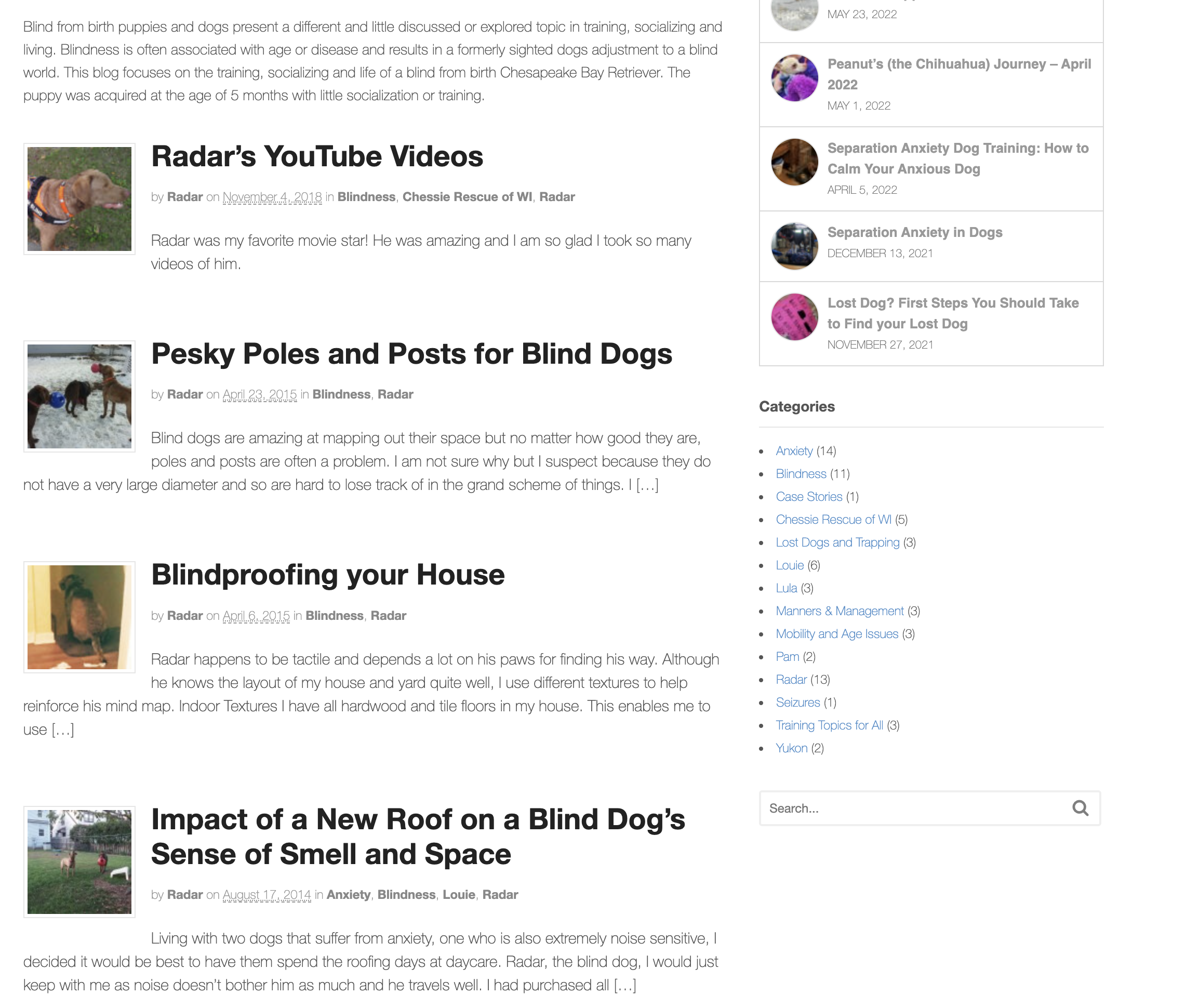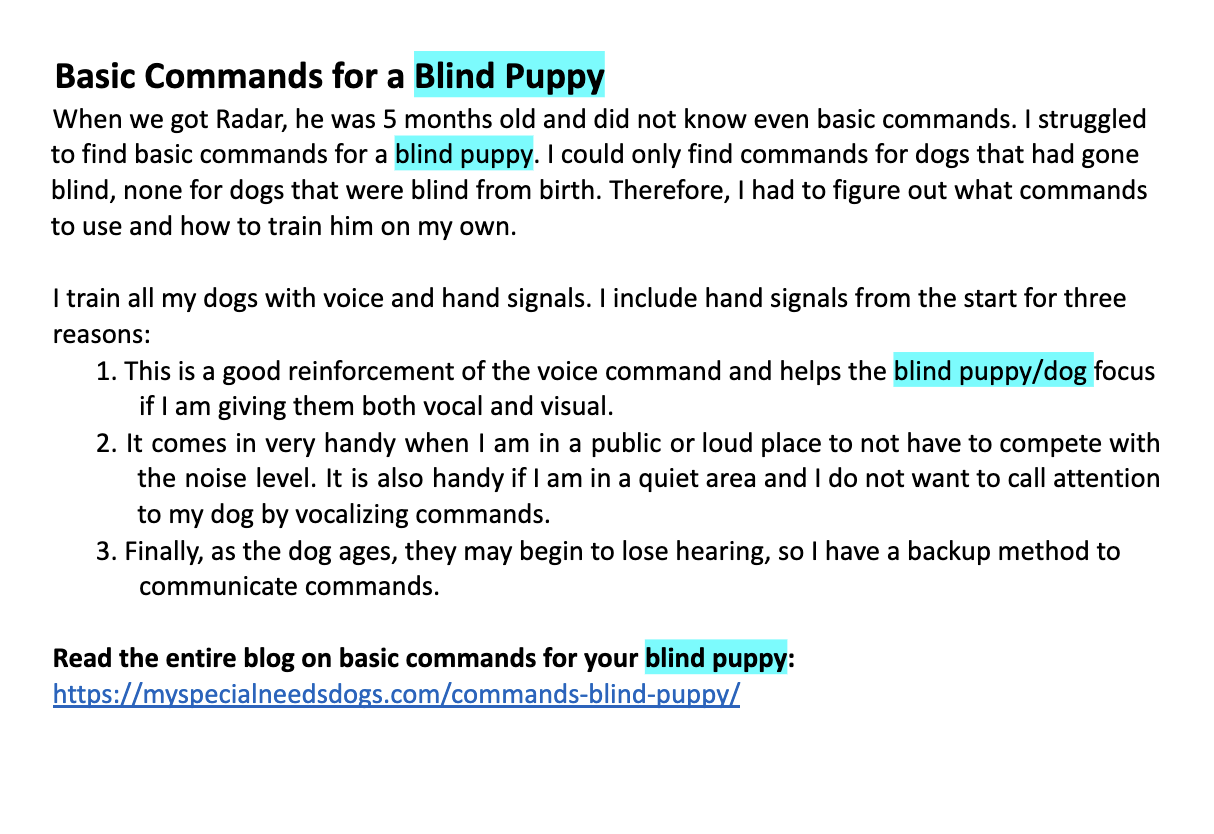SEO Analytic Report: Life w/Special Needs Dog
For my SEO & Marketing Analytics course, I was tasked to revise a landing page for the site Life with Special Needs Dog. I chose to revise the “blindness” page of the website. The video provided will discuss the project and all the tasks that I was responsible for completing.
During this project, I had many tasks including:
- Analyze GA4 metrics to understand what needs improvements
- Create a goal based on those metrics
- Pick important metrics to track
- Conduct a keyword research
- Develop a keyword SEO strategy
- Report content revision recommendations
At the beginning of this project, the “blindness” page needed a complete revision. The page consisted of archive blog posts and didn’t include any information about blind dogs besides an introduction paragraph. The page lacked visual hierarchy and some of the revisions I suggested were adding headings, content, and pictures. In addition, I suggested taking three important blogs about blind dogs and creating content for that page with an internal link to the full blog post. Goals and
Goals for the Landing Page:
- Increase organic search traffic
- Improve user experience
Using GA4, the two goals were created by looking at the following metrics:
- Source/Medium
- Sessions
- Bounce Rate
These metrics are important and will tell us how people find the page, how many actively engage with the page, and how many users exit without interaction.
Starting Metrics:
During the timeframe of August 1st- August 31st, we found our starting metrics.
- Source/Medium: google/organic
- Sessions: 2
- Bounce Rate: 50%
From these starting metrics, we are able to conclude that although the search traffic is already organic, the page has a low amount of visitors and half of those visitors exit without interacting.
Keyword Research:
Before I began my keyword research, I first had to define the target audience. Not only did I need to define the audience, but I also had to understand their needs and why the audience utilizes this page. I concluded that the audience would likely own a blind dog and are looking for training and how-to information for their blind dog.
First, I conducted a Google search to see where the site ranked on Google. Next, I brainstormed keyword phrases. Utilizing Google, Ubersuggest, and Ask the Public, I found a list of keywords that reflected the page’s topics and produced high results. After conducting a keyword overview on Ubersuggest, I narrowed down the keyphrase to “Blindness in Dogs.”
Keyword SEO Strategy:
After choosing the keyphrase, I analyzed the landing page to see how often it appeared. I assessed the on-page presence, keyword variations, and multimedia presence.
On-Page Presence:
- URL: yes
- Page title: 50%
- Headings: No
- Main content: No
- Above the fold: 50% Yes
- External links: No
Keyword Variations: Blind dog, Blind puppy, and Blind dogs were all found within the headers and body text
Multimedia Presence: Keyphrase was not found in any <alt tag>
Recommendations
As stated above, my main goals were to 1. Increase organic search traffic, and 2. Improve the user experience. Because the original landing page was an archive blog post page, my biggest recommendation was to revise the landing page to help visitors find information more efficiently.
Ways to accomplish this included:
- Create page title and tagline
- Add introduction paragraph
- Create three main topics with a defined header, body text, and photos
- Attach blog post links to corresponding topics
- Incorporate the keyphrase and variations into the landing page
Create Page Title and Tagline


Add Introduction Paragraph
Yellow highlights indicate where the key phrase is used throughout the page


Create Three Main Topics and
Link Blog Posts to Content
Blue highlights indicate where the key phrase variations occur throughout the page


Conclusion
Utilizing the SEO tactics listed above and making the following changes will help increase search traffic and the user experience for the blindness page. In addition, understanding Google Analytics and how visitors are using the page will help create goals to improve search traffic and user experience.
Other important things to remember:
1. Keep Content Updated
Consistently updating the landing page and original blog posts will increase search ranking with Google and build authority within the topics of the page and with visitors to the site.
2. Revisit Google Analytics in Six to Eight Weeks
It is important to wait six to eight weeks to analyze the results. Google needs time to “crawl” the site and log the information. After the waiting period, we can visit GA and either create a new goal or adjust the current goal.